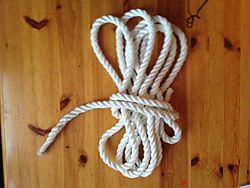The method is also useful for much smaller items such as for keeping earphone cables from tangling.
Tying method
Depending on the thickness and length, one can use palms of hands stretched out to the sides (crossing over the neck), two knees, passive side palm and elbow, or two fingers of the passive hand. The following is for the extra long climbing rope.
Start with both rope ends in one hand. Pull 1.5–2 arm lengths of the pair through and let their ends hang free. Begin coiling the balance of both strands one arm length at a time, alternating the gathers in the opposite hand into two separate "lobes" (or wings) draping on either side. [7]
With 1.5–2 arm lengths remaining secure the coil by wrapping both strands twice round both lobes approximately 1–1.5' down, then pass a short bight above the wraps and through the coil. Pass both free ends over the top of the coil and through the bight to cinch it tight.
Attach the rope for transport by placing the coil atop one's back, with one free end passing over each shoulder. Pass the ends back under the armpits, cross them over the coil, then bring them forward again, securing in front with a square knot.
An alternate method draws the doubled rope over the shoulders instead of in front of the climber.








